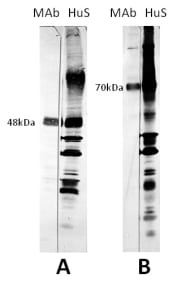Anti-RSV F Glycoprotein [11-3-A3]
Invented by Ayham Alnabulsi from Vertebrate Antibodies Limited
Invented at Vertebrate Antibodies Limited
- Datasheet
- References (7)
- Inventor Info
Info
| Catalogue Number | 151853 |
| Applications | ELISA IF Fn WB |
| Antigen/Gene or Protein Targets | Human Respiratory Syncytial (RS) virus Fusion protein. |
| Synonyms | VGP48, VGP70 |
| Reactivity | Virus |
| Relevance | Human Respiratory Syncytial Virus (RSV) is a major cause of lower respiratory tract illness and is the chief cause of hospitalization for respiratory tract illness in young children.The glycoprotein F is located on the surface of viral envelope, its function is to induce fusion of viral envelope with host-cell envelope resulting in syncytium formation. The glycoprotein F (also named VP70, F0 or fusion protein) consists of two components: F1 (also named VPG48) and F2 (also named VGP26) held together by disulphide bonds. The reported molecular weight of the VGP26 component varies between 20 to 26 kd. |
| Host | Mouse |
| Immunogen | Gradient-purified RSF-44 virus (subgroup A) UV inactivated for 20 minutes at 20C |
| Positive Control | Immunoblot: (see Figure) Indirect immunofluorescence: staining of RSA-2 infected BSC-1 cells |
| Subclass | IgG1 kappa |
| Myeloma Used | P3X63Ag8 |
| Recommended Growing Conditions | Dulbecco’s media containing 20% Fetal Bovine serum (DH20) prepared as follows (for final volume of 300ml: 237ml DMEM plus 60 ml Fetal Bovine Serum plus 3ml L-Glutamine). |
| Strain | Balb/c |
| Notes |
This antibody has a high neutralising activity; 90% plaque neutralization titre of 103 (Gimenez et al., 1996). This property makes it potentially useful for the preparation of reagents for prevention and/or for therapeutic use in managing RS virus infections (for example, vaccines or new–generation man-made antibodies). This antibody reacts with the fusion protein F (also named VP70 or F0 protein) and specifically to a subunit of the F protein, F1 (also named 48kDa). The antibody reacts with the RS virus F1 protein from both subgroups A and B of the virus. New-generation man-made antibodies, based on the 11-3-A3 antibody, could complement the effectiveness of polivizumab (Synagis), which is used to prevent but not treat established RS virus infections (Nature Biotechnology, 2013: 31, 952). Significantly, there was no evidence of antibody dependant enhancement of RS virus infection in vitro for the 11-3-A3 antibody. The enhancing activity was found for other antibodies to the F protein (Gimenez et al 1996). |
| Research Area | Virology |
References: 7 entries
Gimenez et al. 1996. Clin Diagn Lab Immunol. 3(3):280-6. PMID: 8705669.
Fn
Gimenez et al. 1996. Clin Diagn Lab Immunol. 3(3):280-6. PMID: 8705669.
Neutralizing and enhancing activities of human respiratory syncytial virus-specific antibodies.
Europe PMC ID: 8705669
Gimenez et al. 1986. J Gen Virol. 67 ( Pt 5):863-70. PMID: 3517224.
Antigenic variation between human respiratory syncytial virus isolates.
Europe PMC ID: 3517224
Gimenez et al. 1984. J Gen Virol. 65 ( Pt 5):963-71. PMID: 6202832.
Monoclonal antibodies to human respiratory syncytial virus and their use in comparison of different virus isolates.
Europe PMC ID: 6202832
Add a reference
References: 7 entries
Gimenez et al. 1996. Clin Diagn Lab Immunol. 3(3):280-6. PMID: 8705669.
Fn
Gimenez et al. 1996. Clin Diagn Lab Immunol. 3(3):280-6. PMID: 8705669.
Neutralizing and enhancing activities of human respiratory syncytial virus-specific antibodies.
Gimenez et al. 1986. J Gen Virol. 67 ( Pt 5):863-70. PMID: 3517224.
Antigenic variation between human respiratory syncytial virus isolates.
Gimenez et al. 1984. J Gen Virol. 65 ( Pt 5):963-71. PMID: 6202832.
Monoclonal antibodies to human respiratory syncytial virus and their use in comparison of different virus isolates.
Add a reference



![Image thumbnail for Anti-RSV F Glycoprotein [11-3-A3]](https://res.cloudinary.com/ximbio/image/upload/c_fit,fl_lossy,q_auto/04cf127e-7bf4-4a76-8224-651b35f547f2.jpg)
![Image thumbnail for Anti-RSV F Glycoprotein [11-3-A3]](https://res.cloudinary.com/ximbio/image/upload/c_fit,fl_lossy,h_45,q_auto/04cf127e-7bf4-4a76-8224-651b35f547f2.jpg)

